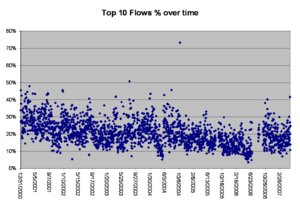Elephant flow

In computer networking, an elephant flow is an extremely large (in total bytes) continuous flow set up by a TCP (or other protocol) flow measured over a network link. Elephant flows, though not numerous, can occupy a disproportionate share of the total bandwidth over a period of time. It is not clear who coined "elephant flow", but the term began occurring in published Internet network research in 2001 when the observations were made that a small number of flows carry the majority of Internet traffic and the remainder consists of a large number of flows that carry very little Internet traffic (mice flows).[1][2] For example, researchers Mori et al. studied the traffic flows on several Japanese universities and research networks.[3] At the WIDE network they found elephant flows were only 4.7% of all flows but occupied 41.3% of all data transmitted during the time period.
The actual impact of elephant flows on Internet traffic is still an area of research and debate. Some research shows that elephant flows may be highly correlated with traffic spikes and other elephant flows (Lan & Heidemann and Mori et al.).[4] Elephant flows have varying definitions proposed by researchers including flows that occupy greater than 1% of total traffic in a time period,[5] measuring the duration of the flow,[6] and looking at flows whose size is greater than the mean plus three standard deviations of traffic during the time period.[4] One of the main goals of research into elephant flows is to develop more efficient bandwidth management tools and predictive models for the Internet. For example, researchers have focused on providing better quality of service to flows of small sizes (mice flows) by de-prioritizing elephant flows.[7]
See also
References
- ↑ Fang, W.; Peterson, L. "Inter-AS traffic patterns and their implications". Global Telecommunications Conference, GLOBECOM '99 (3): 1859–1868.
- ↑ Guo, Liang; Matta, I. (11–14 November 2001). "The War Between Mice and Elephants" (PDF). Dept. of Comput. Sci., Boston Univ., MA, USA: 180–188. doi:10.1109/ICNP.2001.992898. ISBN 0-7695-1429-4.
- ↑ Mori, T.; Kawahara, R.; Naito, S.; Goto, S. (2004). "On the characteristics of Internet traffic variability: spikes and elephants". Applications and the Internet Proceedings. 2004 International Symposium on Applications and the Internet: 99–106. doi:10.1109/SAINT.2004.1266104.
- 1 2 Lan, K.; Heidemann, J. (2003). "On the correlation of internet flow characteristics" (PDF). Technical Report ISI-TR-574. USC/ISI.
- ↑ Estan, C.; Varghese, G. (November 2001). "New directions in traffic measurement and accounting" (PDF). Proceeding of ACM SIGCOMM Internet Measurement Workshop 2001, San Francisco Bay Area.
- ↑ Papagiannaki, K.; Taft, N.; Bhattacharyya, S.; Thiran, P.; Salamatian, K.; Diot, C. (November 2002). "A Pragmatic Definition of Elephants in Internet Backbone Traffic". Proceedings of the 2nd ACM SIGCOMM Workshop on Internet measurement: 175–176. doi:10.1145/637201.637227.
- ↑ Divakaran, Dinil Mon; Altman, Eitan; Primet, Pascale Vicat-Blanc (June 2011). "Size-Based Flow-Scheduling Using Spike-Detection". Proceedings of 18th International Conference on Analytical and Stochastic Modeling Techniques and Applications - ASMTA 2011, Venice, Italy: 331–345. doi:10.1007/978-3-642-21713-5_24.